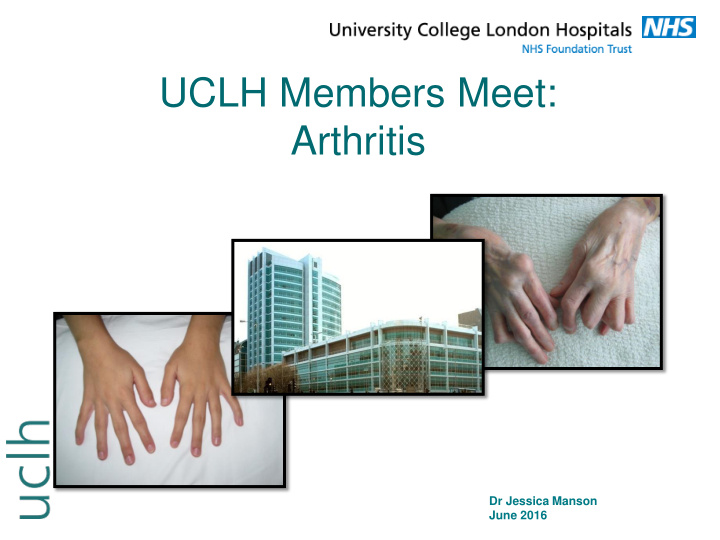



UCLH Members Meet: Arthritis Dr Jessica Manson June 2016
Structure of talk Brief introduction to Rheumatology 1. Department at UCLH What kind of patients do we see? What is arthritis? 2. Definitions Cases Role of the CNS 3. Research in our department 4.
Rheumatology team at UCLH 14 consultants 4 CNS (Sam Moore, lead nurse) Infusion clinic staff 3 full time registrars 3+ research registrars F1 and CMT (50%) Research strong department
Which patients do we see? Referral from GPs and from other hospitals 50-60 Clinics a week 4300 new appointments and 16000 follow-ups per year In patients Very few beds Day case unit Infusions Urgent reviews 4
Rheumatology: what we do Subtotals, 3 month data 1600 Diagnosis % 1400 1200 IA 40 1000 Pain/OA/ 21 HM 800 AIRD 17 600 400 Bone 12 200 Misc 10 0 Total inflamm Total AIRD Total Total bone Total misc arthritis Pain/OA/HM 5
What is arthritis? 6
Arthritis Inflammatory Autoimmune Rheumatoid Spondylo- Crystal rheumatic arthritis arthropathy arthropathy disease Non- inflammatory Osteoarthritis Tendonopathy
3 cases… All presented with joint pain Different diseases Different management 8
Osteoarthritis case 67 year old woman Known obesity, type II diabetes Localized pain and restricted ROM Base of thumb Lumps of fingers Right shoulder Right knee Pain worse on use and end of the day Stiff fingers in the morning 9
Osteoarthritis: patterns of disease http://www.arthritisresearchuk.org 10
Osteoarthritis of the hand 11
12
Osteoarthritis: what the patient can do Pain killers Work a bit Keep active Walking >6000 steps a day predicts good outcome over 2 years in knee OA Lose weight Obesity is a risk factor for OA, even in non-weight bearing joints 13
Osteoarthritis: what doctors can do Dispelling myths It is not wear and tear It is not an inevitable process as we get older Early changes do not inevitably proceed Treatments Phsyiotherapy Analgesia Surgery Research We need a disease modifying drug 14
Rheumatoid arthritis case 21 computer programmer 4 month history of pain in multiple joints Mainly hands and knees Early morning stiffness 4 hours Fatigue
On examination
Investigations: blood tests High inflammatory markers But not always Antibodies in blood But not always 17
What to do when it is not clear Clinical assessment Diagnosis clear Diagnosis unclear Inflammatory arthritis No evidence of MSK US inflammatory arthritis Start treatment Discharge
1 Normal scan 3 Erosion 2 Synovitis 4 Osteophyte
Rheumatoid arthritis: management Treat aggressively and early Steroids Disease modifying drugs Methrexate, sulphasalzine, hydroxychloroquine Biologics The role of NICE
SLE case 30 year woman 3/12 history joint pain, small joints of hands Incapacitating fatigue Rash on face on exposure to sunlight Rash on hands
What is lupus? 1 Malar rash 2 Discoid rash 3 Photosensitivity 4 Oral ulcers 5 Non-erosive arthritis 6 Pleuritis/pericarditis 7 Renal disorder 8 Neurological disorder 9 Haematological order 10 Immunologic disorder 11 Positive ANA
SLE: management and outcome Long term treatment with immunosuppression ?lifelong Careful monitoring especially at high risk times eg pregnancy In this case: Stable, chronic disease Working full time 2 children
SLE: prognosis Hugely improved in last 50 years but… 10 year survival in UK about 95% Which means 5% don’t survive 10 years 25
Summary Arthritis is not a diagnosis 1. Most of our work is done in out-patients looking after 2. inflammatory pathology We have a desperate need for a drug to treat 3. osteoarthritis The last 10-15 years has seen a transformation in 4. the way rheumatoid arthritis is managed Patients often get to know us very well, and vice- 5. versa!
Thank-you. Any questions?
Recommend
More recommend